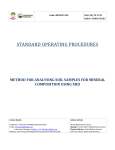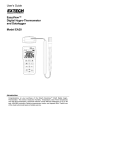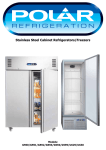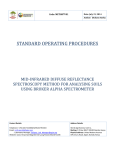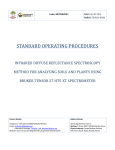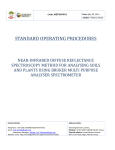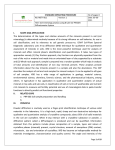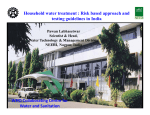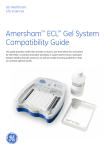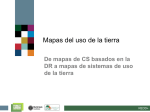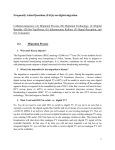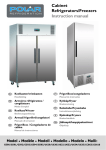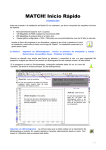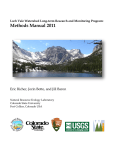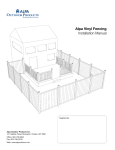Download STANDARD OPERATING PROCEDURES
Transcript
Date: July 30, 2014 Code: METH14V01 Author: Robin Chacha STANDARD OPERATING PROCEDURES METHOD FOR ANALYSING SOIL CLAY FRACTION SAMPLES FOR MINERAL COMPOSITION USING XRD Contact Details: Address Details: Telephone: +254 (20) 7224000/4235/4279/4163 Email: [email protected] : Laboratory Manager, [email protected] Website: www. http://worldagroforestry.org/research/land-health World Agroforestry Centre, Mailing: P.O Box 30677-00100 Nairobi, Kenya Physical address: United Nations Avenue Off Limuru Road, Gigiri, Nairobi, Kenya STANDARD OPERATING PROCEDURE Code: METH14V01 Title: Method for analyzing soil clay fraction samples for mineral composition using XRD Date: July 27, 2014 Author: Robin Chacha METHOD DOCUMENT CONTROL LOG Name and position Signature Author(s) Innocent Mugeni – Laboratory Technician Verifiers Robin Chacha – Senior Laboratory Technician Mercy Nyambura – Laboratory Manager [signature for completeness and correctness of document] [signature for completeness and correctness of document] [signature for completeness and correctness of document] Authorizer Distribution of valid copies of this document: G143G X-Ray Diffraction Lab Revise before: [date] Historical data [dates of previous issues] Date retrieval: [to be filled in once the document has become obsolete and is archived] Changes in this version compared to previous version: [Describe what has changed in the text of this version compared to the previous version] 2|XRD Clay fraction SOP STANDARD OPERATING PROCEDURE Code: METH14V01 Title: Method for analyzing soil clay fraction samples for mineral composition using XRD Date: July 27, 2014 Author: Robin Chacha SCOPE AND APPLICATION The determination of the types and relative amounts of the minerals present in soil (soil mineralogy) is determined routinely because of its strong influence on soil behavior, its use in soil classification, and its relevance to soil genetic processes. ICRAF Soil-Plant Spectral Diagnostic Laboratory uses X-ray diffraction (XRD) technique for qualitative and quantitative assessment of minerals in soils. X-ray diffraction is the most powerful technique used for analysis of minerals and offers mineral phase’s identification and quantification. In the Clay fraction approach, clay fractions are physically separated from the rest of the rock or material and made into an orientated layer of clay supported by a substrate. This analysis provides information about the clay minerals present in a sample and also the abundance. This SOP describes the analysis of soil and rock samples for mineral analysis. It can be applied to all types of soil samples. X-ray diffraction has a wide range of applications in geology, material science, environmental science, chemistry, forensic science, and the pharmaceutical industry, among others. In Agriculture it has application in qualitative and quantitative analysis of actual minerals in top soils and sub soils, in classification of soils in terms of weatherable and nutrient rich minerals to measure soil fertility potential and use of mineralogical data in pedo-transfer functions to directly predict soil functional properties. PRINCIPLE Clay fraction is routinely used as a fingerprint identification technique of various solid materials in the laboratory. It is a high-tech, rapid and cheap technique for qualitative and quantitative analysis of crystalline compounds; when X-rays interact with oriented aggregate mounts of clay mineral particles that are prepared by the filter-peel technique, a diffraction pattern called a diffractogram is produced and can be quantified. Information obtained from this pattern shows the extent of d-spacing expansion and or the contraction indicative of certain clay minerals during subsequent treatments (Air drying, glycolation with ethylene glycol, heating to 300°), the information obtained give types of clay minerals by revealing changes in crystal structure spacing or loss of the structure. XRD has become an indispensable method for materials investigation, characterization and quality control. The angle and intensity of the diffracted 3|XRD Clay fraction SOP STANDARD OPERATING PROCEDURE Code: METH14V01 Title: Method for analyzing soil clay fraction samples for mineral composition using XRD Date: July 27, 2014 Author: Robin Chacha beam recorded by a detector forms a diffraction pattern, which provides information about a sample. Use of the position and relative intensity of a series of peaks is used to match experimental data to the reference patterns in the database such as the Powder Diffraction File (PDF). The PDF contains over 200,000 diffraction patterns of crystalline phases. Modern computers have automated search/match programs that determine what phases are present in a sample by quickly comparing the ds of the unknown to those of known materials in the International Centre for Diffraction Data (ICDD) Powder Diffraction File (PDF). ABBREVIATIONS AND DEFINITIONS Powder Diffraction File (PDF). International Centre for Diffraction Data (ICDD) X-ray diffraction (XRD) RELATED DOCUMENT EQUP 06 XRD EQUP 12 Oven EQUP 23 All software XRD Safety Manual XRD Logbook 4|XRD Clay fraction SOP STANDARD OPERATING PROCEDURE Code: METH14V01 Title: Method for analyzing soil clay fraction samples for mineral composition using XRD Date: July 27, 2014 Author: Robin Chacha RELATED FORMS Soil mineralogy analysis using Bruker D2 PHASER Diffractometer System workflow (WF 10) BA 01 SAFETY AND ENVIRONMENT (Refer to HS 01 XRF Safety manual) The manufacture and use of analytical X-ray instruments is regulated by both federal and state governments. When used properly, X-ray instruments pose few risks to careful users. Care should be taken when using any analytical X-ray instrument. Never put any part of your body in the expected path of the main beam. Strictly only trained personnel should be allowed to operate the XRD spectrometer and should have studied the operator’s manual thoroughly. Manufacturer’s overall radiation safety instructions should be adhered to. Eating, drink, or smokes are prohibited in laboratory. For other safety information refer to Laboratory Safety manual. REQUIREMENTS Equipment a. A D2 PHASER Diffractometer with appropriate software b. Centrifuge c. Oven d. Ultra-sonic probe e. Vacuum pump f. Millipore filtration apparatus vacuum tubing g. Hot plate h. Vacuum pump 5|XRD Clay fraction SOP STANDARD OPERATING PROCEDURE Code: METH14V01 Title: Method for analyzing soil clay fraction samples for mineral composition using XRD Date: July 27, 2014 Author: Robin Chacha Material a. Corundum and quartz standard reference material b. Standard 55mm sample discs made from PMMA c. Innovatek cooler fluid d. glass microscope slides e. Weighing paper f. PH-indicator strips (non -bleeding) g. weighing paper (4"x4") h. spatulas i. carbide or diamond glass scriber or marker pen j. Squeeze bottle with distilled water, k. Hygrothermometer l. Ethanediol m. 500 ml beakers n. Stiff brush or stop cork no. 43 o. Uniform set of sedimentation cylinders (measuring cylinders) with internal depth of 340 ± 20 mm and capacity of 1 L. p. Millipore HTTP ISOPORE, 47-mm, 0.4-micron nominal pore opening cellulose filters q. Desiccators with desiccator shelf r. Tongs s. Deionized water t. Forceps PROCEDURE Clay fraction approach (Refer to METH 11A) a. Rock or soil sample are milled or crushed and sieved through 2mm sieve. About 10g of sample is suspended 500ml of water in a 500 ml beaker. Dispersion is done using 6|XRD Clay fraction SOP STANDARD OPERATING PROCEDURE Code: METH14V01 Title: Method for analyzing soil clay fraction samples for mineral composition using XRD Date: July 27, 2014 Author: Robin Chacha a sonic probe for 5 minutes, then transferred into a 1 L measuring cylinder and filled to the 20 cm mark with deionized water. b. Let it soak overnight to allow material to settle. According to Stuart’s law spherical particles will settle faster below the 5 cm mark while the clay particles which are platy and less than 2 µm in size will remain suspended between the 5 and 20 cm mark. c. Using a siphon tube collect the suspension above the 5 cm mark. Of the measuring cylinder and transfer into a 500 ml bottle for storage d. Oriented aggregate mounts are prepared by the filter-peel technique using a filtration system setup. These are then subjected to different treatments i.e. air drying, glycolation with ethylene glycol, heating to300 ° C and heating to 550° C. e. Place oriented aggregate mounts on the shelf of desiccator. Additional shelves may be stacked if necessary. Do not remove mounts until they are to be run on the X-ray diffractometer. Sample measurement a. Switch on the instrument and let it warm for thirty minutes. (Refer to EQUIP 06) b. Pull down the spherical handle of the stage and place onto sample holder into the sample position of the stage(Goniometer) c. Lift the sample back into the sample measurement position by pulling up the spherical handle of the stage and slide down the instrument door. Press down door handle with force in order to close it correctly. d. Activate the High Voltage e. Set measurement parameters for a typical Lynx eye (Refer to EQUIP 06). f. Select start button to initiate acquisition. 7|XRD Clay fraction SOP STANDARD OPERATING PROCEDURE Code: METH14V01 Title: Method for analyzing soil clay fraction samples for mineral composition using XRD Date: July 27, 2014 Author: Robin Chacha QUALITY CONTROL Sample preparation During sample loading or packing of the sample on the disc holders the key point considered is the preferred orientation and its effect on the diffractogram. One has to be keen on: The density of the packing has to be moderate to allow X-ray beam to go through the particles to achieve maximum good particle statistics. Sample particles must be randomly oriented and have a flat, smooth and homogeneous surface to achieve a good resolution grains less than 10µm is needed. Calibration Standards Mounted corundum standard is used to check verification of the instrument working conditions this is done monthly. Quartz standards are used to check the intensity of the quarts peak in the sample. Maximum counts high peak 9000 but with our method we get more than 3000 counts for the quartz peak and this is a good confirmation of our sample preparation procedure. Phase identification (Refer to QC 03) a. Use a quartz pattern as a quality control peak to check if it has a peak at the right position(at d-spacing of 3.34,4.25,1.80) b. Check if one is able to search and match the other minerals phases by matching the database and the pattern standards to be identified. c. Checking on the reproducibility of the patterns when scanned again .No shifting of peaks at their position, same peak with height and intensity 8|XRD Clay fraction SOP STANDARD OPERATING PROCEDURE Code: METH14V01 Title: Method for analyzing soil clay fraction samples for mineral composition using XRD REFERENCES PHASER user’s manual Doc M88-EXX141 D2PHASER from unpacking to first measurement Doc M88-EXX155 VI D2 PHASER service manual Doc M88-EXX143 VI ATTACHMENTS Knime software File maker software 9|XRD Clay fraction SOP Date: July 27, 2014 Author: Robin Chacha Date: July 27, 2014 STANDARD OPERATING PROCEDURE Code: METH14V01 Title: Method for analyzing soil clay fraction samples for mineral composition using XRD Author: Robin Chacha ANNEX Work Flow This Laboratory uses X-Ray diffraction to determine the soil mineralogy X-Ray Diffraction Laboratory Workflow Objective: For characterizing soil mineralogy as a key determinant of nearly all soil functions properties From Sample Processing Factory Mix sample with water then use sonic probe machine to break the particles Leave suspension for 12hrs in a glass cylinder for it to settle then transfer to plastic containers Prepare the filtration set up then filter the suspension Put the mould on a desiccators for 12hrs then do the first measurement (analysis) Put the desiccators on ethene glyco and place in oven for 12 hrs at 60-70oC. Then take the second measurement(analysis) Place desiccators on hot plate for 20mins then take the final measurement Check the overlay spectra for the three readings Sonics Dispersion Clay Fraction Clay fraction/whole rock approach? All rock Mill approach Add 9g of ethanol to 3g soil sample then mill for 12 min Sedimentation & Siphoning Centrifuge Filtration Decant Ethanol Desiccators' Treatment Hexane Addition at 80oC for 1-4 hrs Sieve Hot Plate to 250µm Clay Fraction Measurement All rock approach Sample Deposition Quality Control Preparation Action point Peak Identification Decision point Tape notes Data Entry Stored data Process route 10 | X R D C l a y f r a c t i o n S O P To Database To Archives Excess sample is archived in capped glass vials 20min for clay fraction and 30min for all rock approach LEGEND Add 0.5ml of hexane to the sample and mix well using voltex mixer Oven Dry Oven Dry Overlay Spectra Transfer sample to cetrifuge tube and place them on centrifuge at 4000rpm for 10mins for soil to settle at the bottom Identify the minerals present using EVA software Put sample in sample holders till compact using a razor blade










